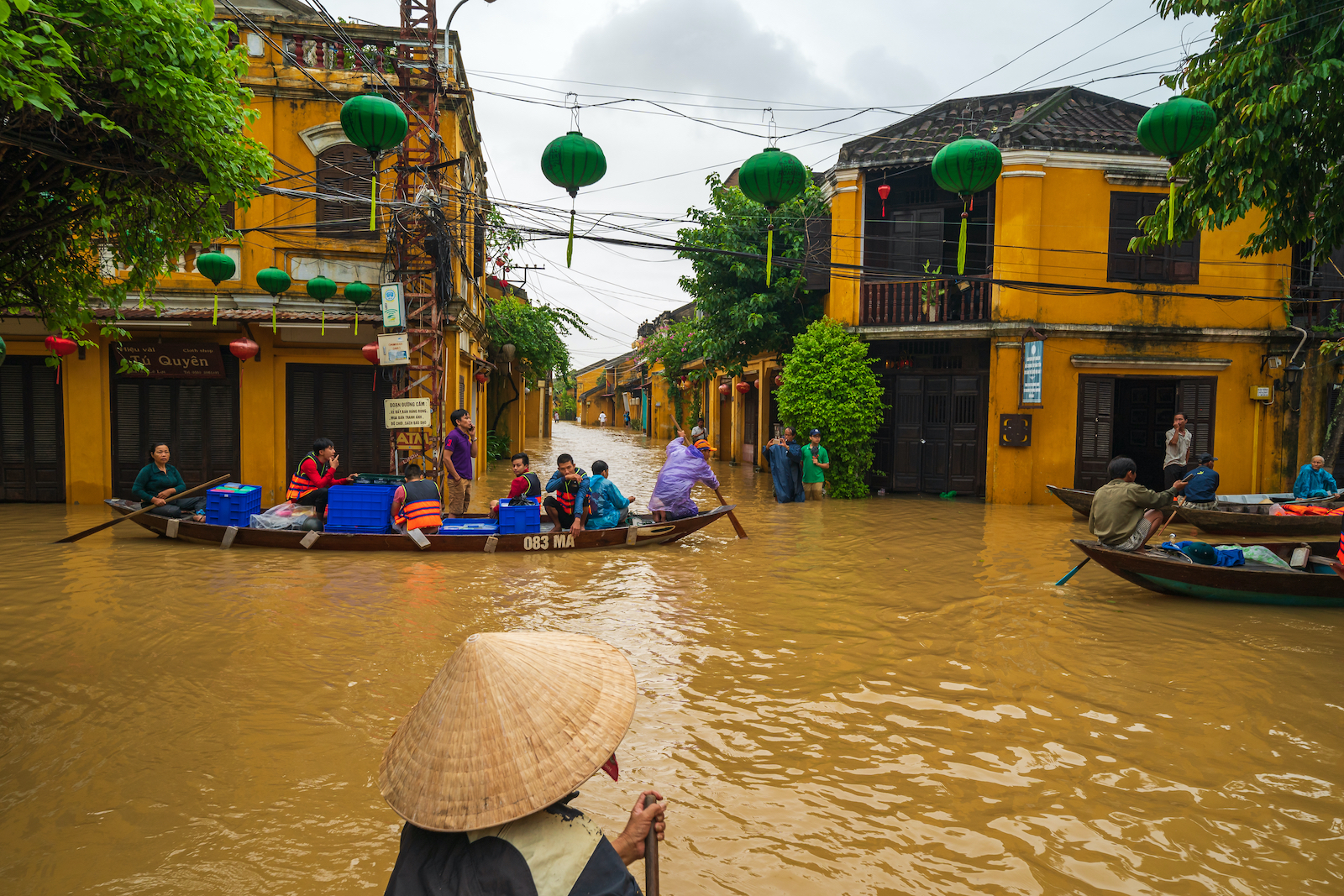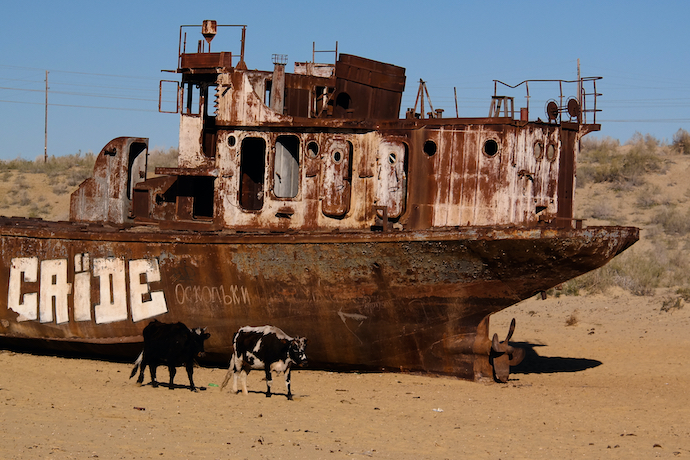
Sinking Cities: The Effect of Climate Change on Mass Migration
Jakarta is sinking.
Indonesia’s capital city, one of the world’s largest metropolitan areas, is rapidly disappearing. The island city is located on the northwestern coast of Java, the archipelago nation’s most populous island, and is home to over 10 million people.
More than 32 million people live in the greater metropolitan area. Jakarta has already sunk nearly 157 inches since 1970, and it sinks lower by an average of 3.9 inches per year. Parts of the city are already nearly uninhabitable, dotted by abandoned buildings submerged in thin layers of stagnant floodwater with nowhere to drain. By 2050, estimates suggest that 95 percent of it will be completely gone.
The sinking is a centuries-old problem, caused largely by the necessity of using groundwater as the primary source of water for the city. As more and more groundwater is used, the level of the earth lowers, causing the surface of the island to drop closer to sea level. And the rapid urbanization and population growth of much of Java has resulted in groundwater being used faster than it can be regenerated. However, the rate of sinkage has been greatly exacerbated in recent years by rising global temperatures and the climate crisis, as the sinking landmass is met with rising seas and increasingly unpredictable weather. But, this is not a situation unique to Jakarta. As climate change continues to worsen, more and more countries are facing an imminent risk of necessary mass relocation. Jakarta is serving as a trailblazer for how countries respond to climate risks.
The concrete walls restraining the Jakarta Bay have proved an insufficient line of defense, with some estimates suggesting that most of the northern part of the city will be underwater by 2030. In January, the government of Indonesia responded, putting plans into motion that have been in the works since 2019. The capital city will relocate – not to an existing city, but to an undeveloped tract of jungle in Borneo. Indonesia’s response is unprecedented, and it could be a sign of the future that the climate crisis will bring.
The new city, called Nusantara, has been touted by Indonesian President Joko Widodo as a new sustainable marvel. Plans for the new capital show that it will feature lush green spaces throughout the city, a detailed public transportation system, energy-efficient high-rises, and an overall city that is “respectful of the environment,” says the firm that drafted the city’s design. However, the hefty $32 billion price tag and a decades-long development process have led to some skepticism as to the reality of this goal.

There are similar concerns over the true efficacy of building a brand-new, ecologically focused city occupying twice the area of New York City on previously undeveloped land in one of the world’s most sensitive ecosystems. In a study, researchers from Virginia Polytechnic Institute warn that the relocation of Indonesia’s capital could become a “major biodiversity catastrophe.”
Borneo is one of the last major forest areas in Southeast Asia, giving it an extremely important ecological role in the region. Despite this, an estimated 30 percent of Borneo has been deforested since 1970, primarily due to infrastructure expansion, logging, mining, and drought-induced forest fires. The island is home to several endangered species and other types of sensitive wildlife, including orangutans, leopards, sun bears, and pygmy elephants, which face a substantial threat from forced relocation.
There is a high possibility that many of the social and economic issues faced by Jakarta will not disappear with simple relocation. The high rates of urban sprawl, significant population increases, high road traffic, and high rate of air pollution present issues that need to be planned for and solved before the relocation can take place. Science Magazine also acknowledges that environmental groups worry that Nusantara will rely on energy from the numerous coal plants already present in Indonesia’s section of Borneo, increasing production in these plants and worsening pollution. Significant increases in air traffic between Nusantara and Jakarta are likely to occur.
Even as its government looks to move a reported 1.5 million civil servants to Nusantara, the population of Jakarta shows no sign of shrinking. Much of the 32 million people living in the greater Jakarta region will still be at risk. While government agencies and embassies look to move, previous plans to increase the infrastructure of Jakarta, including the building of a massive seawall to keep the fast-rising tides at bay, will continue. The movement of the political capital of Indonesia does no assistance to much of the 65 percent of the country’s population still living on Java. The movement of government will likely not have much influence on the deep industrial roots of Jakarta, creating the potential for stagnant urgency to move from the sinking city.
Crazy photo of flooded cabs in Hoboken: “@LauraLoo23: Taxis underwater- Hoboken #Sandy pic.twitter.com/o1Xv297V” #sandy #SandyNYC
— Ryan Adams (@RyanAdamsPA) October 31, 2012
This leaves the question – what will happen to the rest of Jakarta’s population?
The plight of Jakarta represents one of the first major instances of a city at an imminent risk of climate change-rooted destruction in the Anthropocene era, and it reveals just how complex the problem will become as more and more places become uninhabitable. From desertification causing extreme drought and famine, to rising sea levels threatening coastal cities and islands, to shifting agricultural patterns and excessive pollution, the threat of global mass climate migration is becoming more and more of a reality.
Some countries have taken similar steps as Indonesia to ensure their future. Kiribati, a small Pacific Island nation, purchased 5,000 acres of land in nearby Fiji as a ‘backup plan’ in case the country’s conservation efforts fail. Kiribati, which has a population of 102,000, is at an imminent risk of disappearing due to rising sea levels. It sits just two meters above sea level, and two of the nation’s roughly 100 islands have already been completely submerged.
Many countries, including Kiribati, have resources to assist in their fight against climate change. But not all nations have that luxury. Haiti is the poorest country in the Western Hemisphere, and also one of the most vulnerable to climate change and natural disasters due to its location. The country lacks many of the resources necessary for disaster prevention and recovery, leading to natural disasters causing near-complete devastation. As climate change causes more and more extreme disasters, this situation will only get worse, making it more and more difficult for Haiti to develop.
Though specific data on the number of displaced people due to climate-related factors has not yet been studied, the number of individuals displaced by disaster in 2021 was the highest in a decade, even despite generally low rates of global migration due to COVID. Estimates by The World Bank suggest that by 2050, over 200 million people could face internal environmental displacement. And in countries where issues such as desertification and deforestation will lead to massive stretches of uninhabitable land, and as storms increasingly become more and more unprecedentedly massive, the problem may turn international.
The question of how to handle climate refugees is a question increasingly being posed by international actors. Despite resembling refugees, climate migrants fleeing unlivable areas are not afforded the same legal protections granted to traditional refugees. 30.7 million individuals were internally displaced due to disaster in 2020 – the highest figure in a decade. This is compared to the 20.7 million individuals considered refugees under the UN Refugee Committee’s requirements and is well up from the 21.5 million people displaced due to disaster in 2018.
As climate change worsens, the rate of displaced people will continue to be an issue that the world needs to address. Jakarta is just the beginning. Currently, much of the action to tackle individual disasters caused by climate change is purely on a state level. In order for this issue to be best addressed, it is imperative that actors recognize the imminence of this problem and create structures to support individuals and countries facing disaster. Climate change will undoubtedly shape the international system in the 21st century, and the world needs to be ready.

